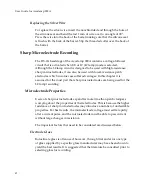
Guide
to
Electrophysiological
Recording
Tip
Resistance
Tip
resistance
(R
e
)
should
be
as
low
as
possible
and
consistent
with
good
impalements
of
the
cell.
Low
values
of
R
e
allow
for
greater
stability
and
faster
settling
time
of
the
microelectrode.
Stability
R
e
of
most
microelectrodes
changes
with
time
and
with
current
passing.
R
e
is
affected
not
only
by
the
magnitude
of
the
current
but
also
by
its
polarity.
In
general,
microelectrodes
of
lower
resistance
are
more
stable
during
current
passing
than
those
of
higher
resistance.
Settling
time
The
decay
time
constant
of
the
microelectrode
voltage
after
a
current
pulse
depends
strongly
on
R
e
.
Thus,
lower
R
e
values
produce
faster
settling
times.
As
well,
high
R
e
values
are
sometimes
associated
with
a
slow
final
decay
even
after
the
electrode
capacitance
has
been
eliminated.
Microelectrode
Capacitance
The
settling
time
of
a
microelectrode
depends
not
only
on
R
e
but
also
on
the
transmural
capacitance
(C
t
)
from
the
inside
of
the
microelectrode
to
the
external
solution.
For
fastest
settling,
C
t
must
be
as
small
as
possible.
C
t
is
usually
1–2
pF
per
mm
of
immersion.
In
order
to
reduce
the
effect
of
C
t
,
two
approaches
may
be
taken.
One
is
to
electronically
compensate
C
t
using
the
Pipette
Capacitance
Neutralization
control
in
the
Axoclamp
900A
Commander.
This
is
discussed
below,
in
the
section
on
“Impaling
Cells”.
The
other
approach
is
to
minimize
the
problem
by
careful
experimental
design,
as
follows.
In
an
isolated
preparation,
lowering
the
surface
of
the
solution
as
far
as
possible
can
reduce
C
t
.
For
a
long
slender
microelectrode,
200
μ
m
or
less
is
regarded
as
a
low
solution
level;
500
μ
m
is
tolerable.
Deep
is
regarded
as
1
mm
or
more.
For
a
microelectrode
that
tapers
steeply
(
i.e.,
a
stubby
microelectrode)
deeper
solutions
can
be
used
with
less
loss
of
performance.
When
working
with
very
low
solution
levels
there
is
a
risk
of
evaporation
83














































